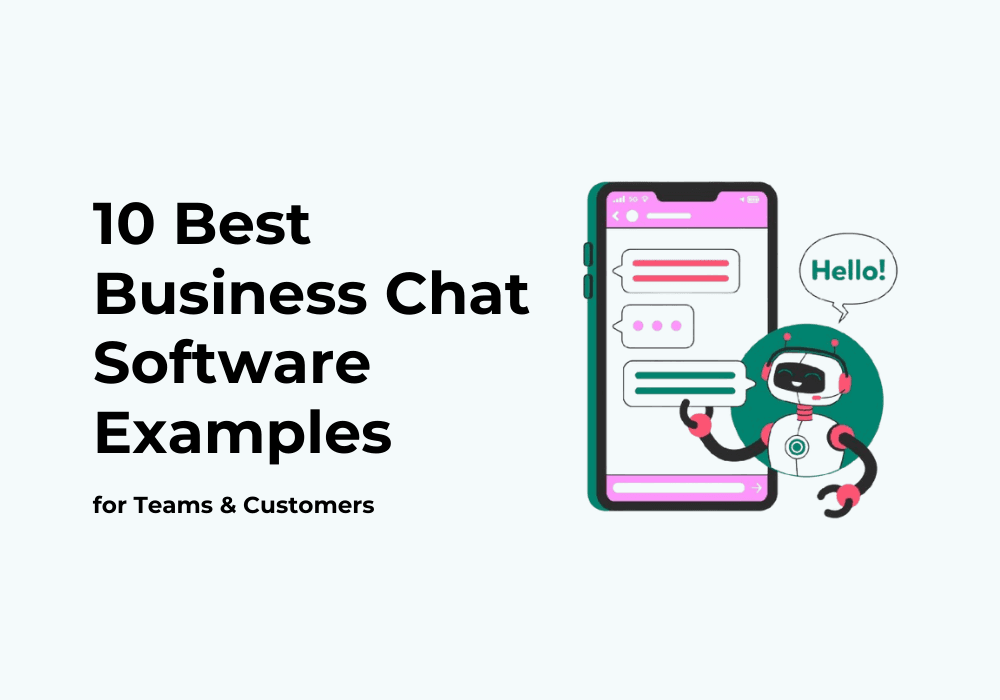March 29, 2025
HR Chatbot: Benefits, Features, and Best Practices in 2025
Due to technological advancements, organizations have transitioned from traditional to remote and hybrid workforces. This shift has significantly transformed how businesses manage their operations.
Now, organizations heavily invest in HR chatbots to streamline operations, improve communication, and enhance employee experiences.
Human resource (HR) chatbots are uniquely versatile. These robust HR-related tools, or chatbots, are proactive partners in engagement. They provide instant support, answer questions, guide users through processes, and even offer personalized recommendations.
HR Chatbots automate a lot of tedious, repetitive, and time-consuming HR tasks and processes to improve employee experience and the overall efficiency of the organization.
In this article, we’ll delve deeper into the meaning, types, use cases, real-life examples, benefits, and HR tasks and processes that can be automated using HR chatbots.
Key Takeaways:
- HR chatbots have emerged as essential tools for streamlining human resources functions.
- HR chatbots automate tedious, repetitive, and time-consuming HR tasks to improve efficiency.
- They offer 24/7 support for job applicants, employees, and HR personnel.
- HR chatbots reduce HR workload, allowing them to focus on more strategic responsibilities such as talent development
- AI-powered personalization enhances employee experiences by providing personalized responses based on user preferences.
What Is A Chatbot?

A chatbot is an artificial intelligence program designed to simulate human conversations and interact with users in a natural language format. Chatbots can be utilized in various industries, including Human Resources Management (HRM). Their application in the field of Human Resources (HR) has proven to be particularly beneficial.
When a conventional chatbot is trained to do human resources-related tasks and processes, it will be transformed into an HR chatbot. AI-powered HR chatbots automate human-like interactions with prospective candidates and employees within an organization.
What Is HR Chatbot?
HR chatbot is a conversational software solution that provides instant HR support to the user. It interacts with employees, job applicants, and HR personnel to provide instant responses, manage queries, and facilitate HR functions like recruitment, onboarding, and employee engagement.
AI-based HR solutions help to understand and automatically resolve HR inquiries related to employee onboarding processes, performance evaluations, training, and development programs. This tool leverages the power of Generative AI and NLP technologies to answer questions and provide information on company policies, benefits, and procedures. All inquiries are instantly responded to in a human-like and personalized manner, thereby enhancing efficiency and accuracy.
The function of the HR chatbot is not only limited to the above. As proactive partners in engagement, they assist in collecting employee feedback, conduct surveys, and facilitate employee self-service. This allows HR agents or professionals to focus on strategic and complex initiatives and responsibilities.
Types of HR Chatbots
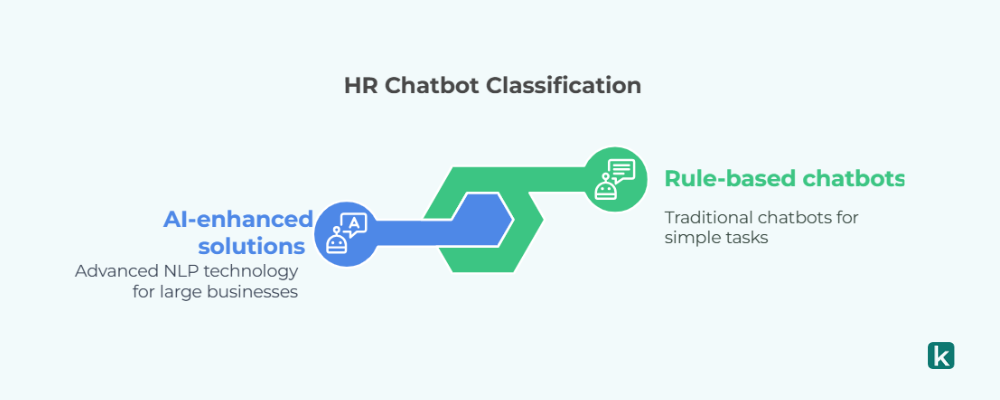
HR chatbots are classified into rule-based and AI-based chatbots. Each type has its own unique features.
Rule-based chatbots
These are also known as traditional chatbots. It is typically designed for small and medium-sized businesses or organizations that do not have complex tasks and many policy changes.
AI-enhanced solutions
This type of HR chatbot uses advanced technologies of NLP to provide assistance to individual employees. They are more suitable for large businesses with different HR policies.
Essential Features of HR Chatbot
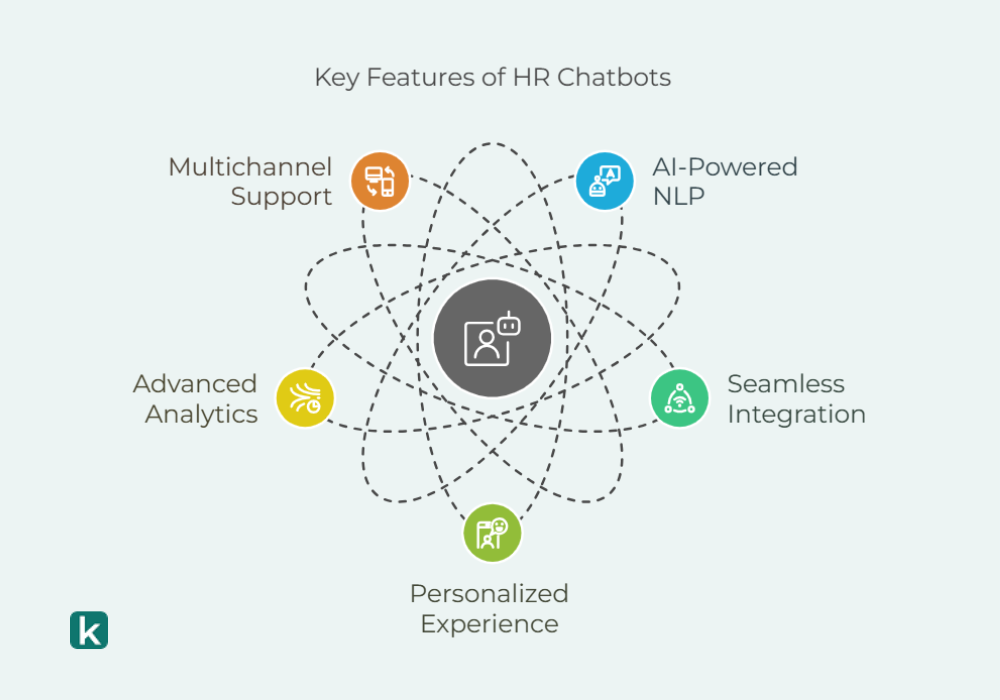
HR chatbots must have the following features to achieve optimal outcomes in HR task delivery:
- AI-Powered Natural Language Processing (NLP): Interprets employee queries accurately and generates relevant and personalized responses.
- Seamless Integration with HR Systems: Integrates with HRMS, payroll software, and internal databases for instant accessibility to information.
- Personalized Employee Experience: Chatbots should deliver customized responses based on employee roles, departments, and previous interactions.
- Advanced Analytics and Insights: HR chatbots should analyze employee concerns, improve policies, and enhance HR strategies.
- Multichannel Support and Accessibility: A well-designed chatbot operates across multiple platforms, including Slack, Microsoft Teams, and mobile apps, ensuring accessibility.
Top 5 HR Chatbots Examples You Should Know
- Kelpo AI – A customizable chatbot that cuts support costs by 98%. Kelpo.ai isn’t just for customer support, it’s flexible enough to handle your HR needs too. You can customize it to answer employee questions, streamline onboarding, manage leave requests, and more. Trained on your internal processes, Kelpo becomes a 24/7 HR assistant that fits right into your workflow.
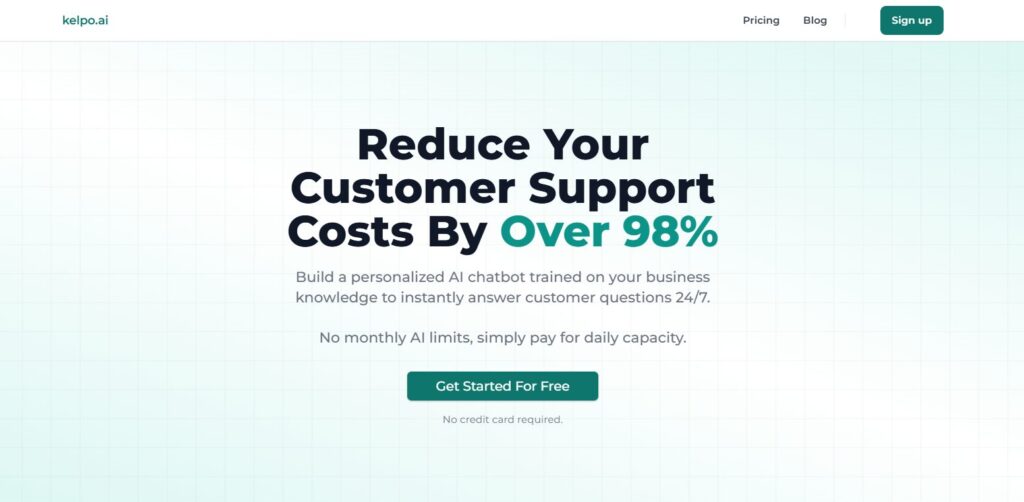
2. PeopleHum – Simplifies performance management and employee engagement with smart automation. PeopleHum helps align individual goals with company objectives while simplifying feedback and reviews.
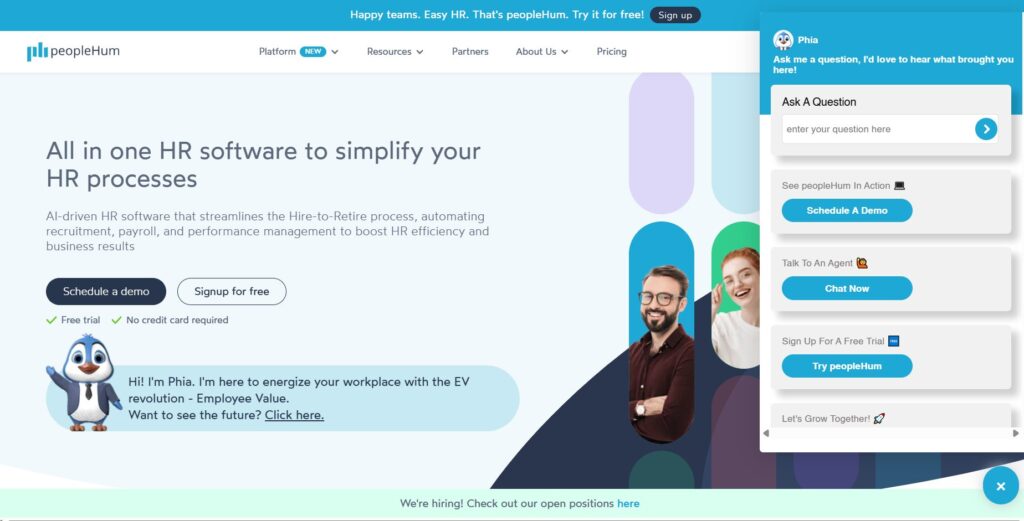
3. Leena AI – Your AI-powered HR assistant that automates everyday tasks like answering FAQs, managing leave requests, and improving the employee experience with instant support.
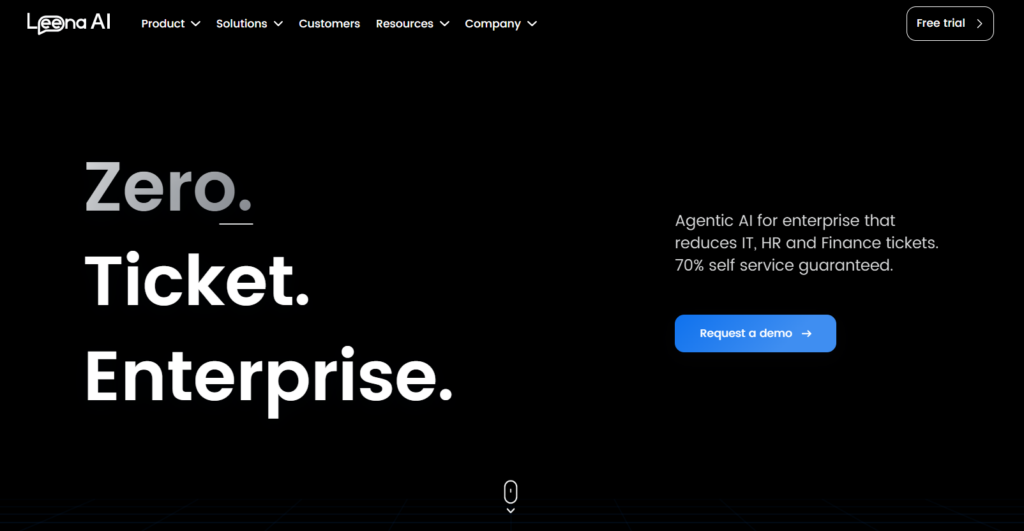
4. Paradox Olivia – A recruitment chatbot that accelerates hiring. Olivia screens candidates, schedules interviews, and keeps applicants informed, making recruitment faster and more personal.
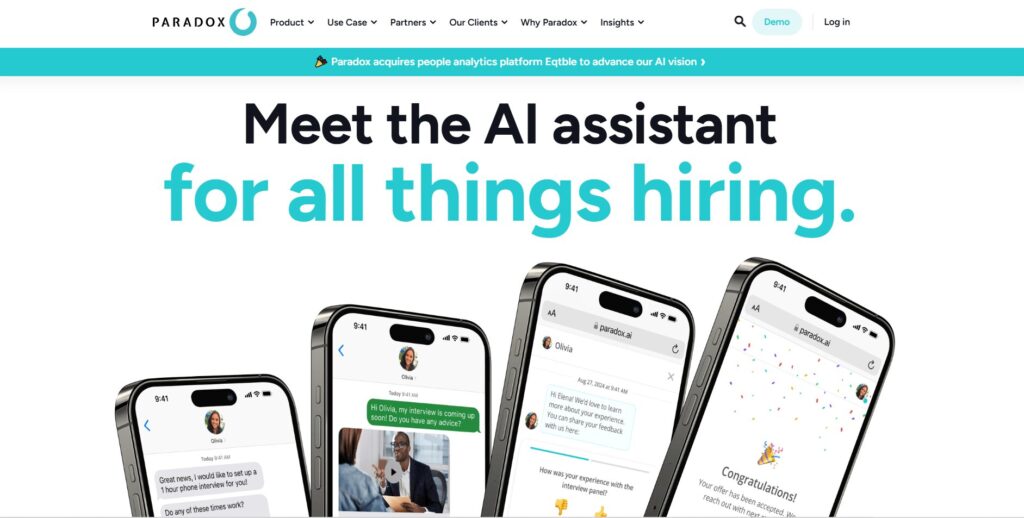
5. HireVue – Make hiring faster and fairer with HireVue’s AI-powered video interviews and skills assessments. It helps you spot top talent quickly with structured interviews and smart insights, all while giving candidates a smooth, stress-free experience.
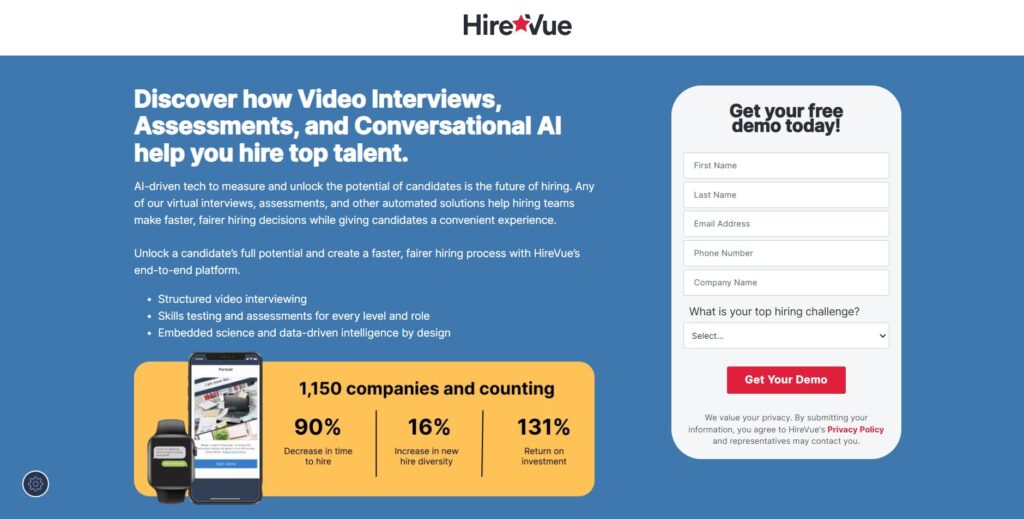
Best HR Chatbot Use Cases For Business
Human resource management is crucial for the productivity and success of any organization. The HR department is saddled with the responsibility of recruiting, selecting, training, and developing employees for achieving the organization’s overall objectives.
In today’s evolving business landscape, the HR department handles a high volume of queries daily, often ranging from 50 to 500+ per day in medium to large enterprises, including inquiries about interview status, technical support, appraisal status, job applications, and payroll details. These tasks can be overwhelming when handled manually. Hence, the need for HR chatbots to help mitigate this challenge.
This task can be sometimes overwhelming, especially for large organizations. Hence, the need for HR chatbots for a seamless experience. The use of HR chatbots has enabled 24/7 availability of HR management and quick response time.
It can develop solutions to assist its experts with several aspects of employee management. Here are the most common use cases for businesses:
1. Improved Recruitment and Selection
Recruitment and selection are crucial aspects of HR management, and HR chatbots can help revolutionize these processes. During the selection of the best employee for a particular job opening, the HR department will be burdened with many resumes, cover letters, and other documents submitted by applicants.
The presence of HR chatbots simplifies these HR tasks and processes. It helps to engage with applicants, answer questions, and provide relevant information about the job requirements. HR chatbots help screen candidates based on predefined and standardized criteria, ensuring that only qualified candidates proceed to the next stage.
By automating the initial stages of the recruitment process, chatbots minimize administrative burden and save HR professionals valuable time and effort. HR chatbots also help schedule appointments and answer questions about the organization. The features of modern AI-based tools are so human-like that 73% of applicants can’t recognize that they are talking to them.
Real-life Example

IBM used predictive analytics to find candidates who were not just qualified but also likely to stick around. By studying past hires and their success, they boosted new hire retention by 25%.
2. Onboarding
Onboarding is the process of integrating and familiarizing new employees with an organization, its culture, policies, and job responsibilities. After the selection process, it is paramount for the new employees to acclimate to their roles and responsibilities assigned to them.
Instead of HR professionals spending time explaining the various aspects of the work process to new employees one-on-one, HR chatbots can assist with this. This tool can provide information about organization policies, benefits, cultures, procedures, and guide new employees to complete their tasks.
HR-driven chatbots speed up the onboarding process by providing all this information. With their help, new employees get instant access to relevant resources, materials, and checklists.
Real-Life Example
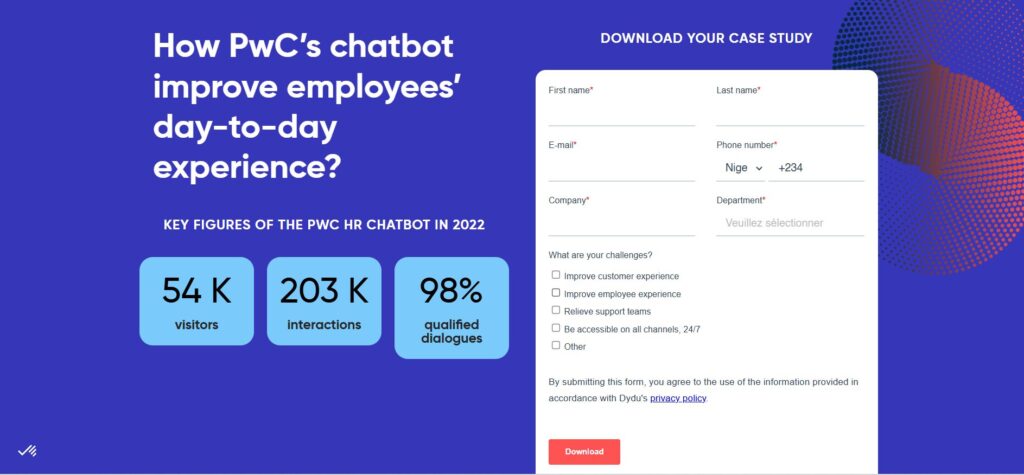
A global professional services firm, known as PwC, uses an HR chatbot to assist new applicants during onboarding. The chatbot provides personalized guidance, answers frequently asked questions about company policies and helps employees complete onboarding paperwork.
This automation has improved onboarding efficiency and employee engagement from day one.
3. Performance Appraisal
The systematic evaluation of an employee’s job performance over a specific period is important for the continued success of an organization. To ensure steady workflow and timely delivery of projects, organizations need to track employee performance.
HR chatbots are instrumental in employee performance management. It revolutionizes the way organizations conduct performance appraisals by automating processes and providing real-time feedback. AI-based solutions identify employees’ strengths and weaknesses by collecting and analyzing employee data.
They can ask performance-related questions, track progress on goals, and generate reports for HR teams. Chatbots can collect multi-source feedback (known as 360-degree performance reviews) by prompting employees, supervisors, and team members to provide performance insights.
This fosters a more holistic and unbiased evaluation. Thus, maximizing time, labor, and resources for the organization’s productivity
4. Feedback Collection
For improved employee engagement and organization productivity, feedback collection is crucial. Owners must listen to the opinions and views of their employees.
HR Chatbots can make the process of feedback collection seamless. It offers a safe, confidential, and anonymous environment where employees can express themselves freely without fear of judgement.
Real-Life Example

Robofy makes employee feedback simple and effective. Easily collect honest insights from your team with our AI-powered chatbot. Improve engagement, streamline HR tasks, and make smarter decisions with Robofy by your side.
5. Employee Attendance and Absence
AI-powered HR chatbots help to track the attendance and absence of employees. It facilitates real-time check-ins and check-outs, absenteeism, shift scheduling, and efficient daily tracking.
They automate attendance logging and approval processes, thereby enhancing communication between employees and HR departments. This saves time and minimizes errors relating to those processes.
Benefits Of HR Chatbots

Human resource chatbots have numerous benefits for organizations. They are:
24/7 Accessibility
HR chatbots provide 24/7 service for applicants and employees. Job applicants easily get answers to questions on job openings during the recruitment process. They also fit into their roles easily through these chatbots guidance.
Unlike human HR personnel, chatbots provide round-the-clock support, ensuring employees get immediate answers to queries about leave policies, payroll, performance reviews, and benefits.
Time and Cost-Effective
The use of HR chatbots reduces time spent on different HR tasks. Responsibilities such as recruiting, selecting, onboarding, training, and development that would have been done manually, are easily and quickly done by these AI-based tools.
They perform everyday HR tasks, such as answering frequently asked questions and providing instant support. By automating these tasks, time and resources would be maximized.
Improved Productivity
HR chatbots handle tedious and repetitive tasks and requests. They drastically cut the daily workload of HR departments. With their assistance, HR professionals focus on more complex and strategic initiatives, thereby enhancing delivery and productivity.
Boosts Employee Engagement
With the implementation of these tools, employee engagement has increased. Employees can easily access HR-related information about their annual perks, medical benefits, work policy, etc., and receive prompt responses without waiting for a human HR support agent.
Challenges encountered during the course of their work and complaints raised are directed to the right quarters by HR chatbots and promptly addressed. This quick availability boosts employee satisfaction and engagement.
HR chatbots foster better employee interaction by providing personalized recommendations on training programs and career growth.
Best Practices for Implementing an HR Chatbot
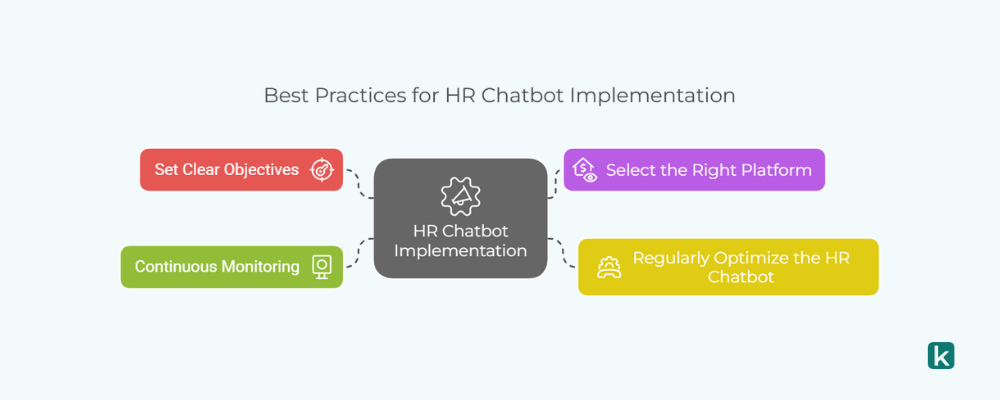
As businesses integrate HR chatbots in their workforces to enhance HR operations, it is crucial for them to adopt a strategic approach in its implementation to maximize its effectiveness. Here are essential steps to follow:
Set Clear Objectives
When implementing an HR chatbot, you should set clear objectives and use cases. Define the specific HR tasks the chatbot will handle to ensure its effectiveness.
Tasks such as answering frequently asked questions, attending to employee queries, providing support to applicants, and so on, can be automated.
Select the Right Platform
During the implementation phase, choose the right AI chatbot platform. Prioritize a platform that offers personalization, integration capabilities, and scalability, and aligns with the organization’s needs.
Regularly Optimize the HR Chatbot
It is crucial that you constantly train the chatbot for accuracy. Regularly update the automation processes and knowledge base to maintain accuracy and reliability. As new developments and issues arise in HR operations, optimize the chatbot for better outcomes.
Continuous Monitoring
HR chatbots should be monitored to ensure better performance of their functionalities.
FAQs
What Are HR Chatbots?
HR chatbots are AI-powered virtual assistants designed to automate and streamline HR-related processes and procedures. It answers questions and provides instant support and relevant information to applicants and employees in the workplace.
What Are the Benefits of HR Chatbots
HR chatbots offer several advantages for organizations. They included enhanced efficiency and engagement, 24/7 accessibility, time and cost-effectiveness, and increased productivity.
What Tasks Can HR Chatbots Perform?
HR chatbots and related tools can perform various functions, such as:
- Provide answers to applicants about job openings and requirements.
- Assist with onboarding and training new employees
- Answer employee questions about policies, benefits, and procedures.
- Manage recruitment and selection processes.
- Schedule appointments
- Collect employee feedback and conduct surveys.
